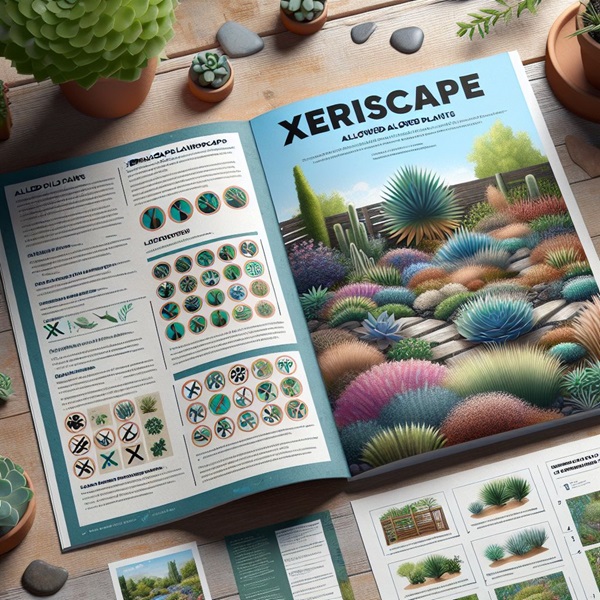
Key Takeaways
- Texas law allows homeowners to implement
despite HOA preferences, within reasonable guidelines. - Xeriscaping is a sustainable landscaping method that conserves water and is ideal for Texas’s climate.
- Understanding the specific HOA rules and the plant species allowed is crucial for a successful xeriscape garden.
- Proper soil preparation and irrigation are key to maintaining a healthy xeriscape.
- Selecting the right plants not only complies with HOA rules but also ensures a vibrant, drought-resistant garden.
Embracing Xeriscape: Transformative Gardening in Texas
When we talk about transforming our gardens in Texas, xeriscaping is not just a buzzword; it’s a movement. It’s about creating a landscape that not only withstands our scorching summers and water restrictions but also thrives in them. And here’s the best part: the law is on our side.
The Shift Towards Sustainable Xeriscape
Imagine your garden as a lush oasis that asks for little water and gives back so much more. That’s what xeriscaping is all about. It’s a smart choice in our often arid climate, and it’s gaining popularity for good reason. Homeowners are now looking beyond the traditional, water-guzzling lawns and seeking alternatives that are both beautiful and environmentally responsible.
Xeriscape Essentials: What It Is and Why It Matters
Xeriscaping is landscaping designed specifically for areas that are susceptible to drought, or for properties where water conservation is practiced. Derived from the Greek word ‘xeros’ meaning dry, the term means literally ‘dry landscape’.
Why does it matter? Because water is a precious commodity in Texas. By reducing the need for irrigation, we’re not only saving water but also creating a garden that can flourish in our local conditions. Plus, it’s a cost-effective approach in the long run, reducing your water bill and maintenance efforts.
Texas HOA Landscaping Rules Simplified
So, you’re ready to take the plunge into xeriscaping, but there’s a hurdle: the Homeowners Association (HOA) rules. Let’s simplify it. In Texas, HOAs can’t outright deny you the right to xeriscape. However, they can set reasonable guidelines that you’ll need to follow. It’s about finding that sweet spot between following the rules and creating the water-wise garden of your dreams.
Understanding Your Rights Under Texas Law
Under Texas law, specifically House Bill 449, homeowners have the right to use xeriscaping in their yards. HOAs can still require you to submit a plan for approval, but they can’t reject it without a good reason. This law is a game-changer, giving you the freedom to embrace sustainable gardening practices.
Navigating HOA Approval for Your Xeriscape Plan
Getting your xeriscape plan approved by your HOA might seem daunting, but it’s doable with the right approach. Start by reviewing your HOA’s landscaping guidelines. Then, design your xeriscape plan to align with these guidelines. When you submit your plan, include details about the plants you intend to use, the design layout, and how it will enhance the aesthetic of the community.
Table of HOA Requirements
| Plant Type | Maintenance Requirements | HOA Approval Required |
|---|---|---|
| Drought-resistant | Regular trimming | Yes |
| Native plants | Weed-free beds | Yes |
| Water-conserving | Borders maintenance | Yes |
| Xeriscaping law | Mulch usage | Yes |
| Texas state law | Irrigation reduction | No |
References:
Plants Make Perfect: Xeriscape Varieties for Texas Climate
Choosing the right plants is critical when it comes to xeriscaping in Texas. You want species that are tough enough to handle the heat, yet still provide that curb appeal we all love. It’s all about selecting plants that are in harmony with our local climate and soil conditions.
Drought-tolerant Heroes: Top Picks for Your Garden
Let’s talk about the champions of a Texas xeriscape garden. These are the plants that not only survive but thrive with minimal water. Consider adding these drought-tolerant heroes to your garden:
- Lantana: This hardy perennial offers vibrant flowers and can handle the heat like a champ.
- Texas Sage: With its silver foliage and purple blooms, it’s a showstopper that’s also incredibly drought-resistant.
- Agave: These sculptural beauties make a statement and require very little water.
- Yucca: Its striking appearance and resilience make it a favorite in xeriscaped yards.
- Zinnia: For a pop of color, zinnias are drought-tolerant and perfect for a sunny spot.
These plants are not just survivors; they’re also easy on the eyes and on your water bill. By incorporating these into your landscape, you’re setting the stage for a garden that’s both sustainable and stunning.
Forbidden Flora: What Not to Plant Even If You Love It
Just as important as knowing what to plant is knowing what not to plant. Some species may be gorgeous but are water hogs, and they’ll struggle in a xeriscape. Here are a few to avoid:
- English Ivy: While lush, it requires a lot of water and can become invasive.
- Hydrangeas: These beauties need more water than a xeriscape can usually provide.
- Fescue Grass: Traditional lawns like fescue demand a lot of irrigation and maintenance.
Steering clear of these thirsty plants will save you from a world of watering woes and keep your HOA happy. For more information on suitable plants, check out this guide on drought-resistant plants for Texas xeriscaped backyards.
The Allowed Palette: HOA-Approved Plant Lists
Before you get your hands dirty, it’s crucial to check your HOA’s approved plant list. This list typically includes species that are known to perform well in your area and meet the aesthetic standards of the community. It’s a helpful guide that ensures your xeriscape is both beautiful and compliant.
Breaking Down the Recommended Species for Xeriscaping
Most HOAs will have a list of plants that they’ve given the green light for use in landscaping. These often include native plants that are accustomed to the local climate and soil. Here’s a breakdown of some common categories you might find on these lists:
- Natives: Plants like Bluebonnets and Indian Paintbrush are native to Texas and are excellent for xeriscaping.
- Adapted Non-natives: Some non-native plants have adapted well to Texas conditions and are often included, like
and Rosemary. - Grasses: Ornamental grasses such as Blue Grama and Buffalo Grass are often approved for their low water needs and natural beauty.
By choosing from this palette, you can create a landscape that’s both HOA-compliant and resilient against the Texas heat.
Crafting a Colorful, Multi-textured Xeriscape Design
Designing a xeriscape doesn’t mean sacrificing color or texture. In fact, it’s an opportunity to get creative with a variety of plants that offer different hues and structures. Consider combining flowering perennials with ornamental grasses for a dynamic look. Use succulents for architectural interest and groundcovers to fill in the gaps. With a thoughtful design, your xeriscape can be a tapestry of colors and textures that captivate all year round.
Cost-effective Landscaping: Analyzing the Financial Benefits
Let’s talk numbers because a beautiful garden should make sense financially, too. Xeriscaping can save you a significant amount on your water bill. After the initial setup, the maintenance costs plummet compared to traditional lawns. Imagine slashing your water usage by up to 50% or more. In the long term, xeriscaping is an investment that pays off, not just for your wallet but for the environment as well.
Alluring Aesthetics: Designing Your Xeriscape
Designing a xeriscape is like painting a landscape; it’s an art form that uses plants and earth as its medium. The key is to create a visually appealing space that complements your home and fits within the local ecosystem. It’s about striking a balance between beauty and sustainability.
To start, sketch out your space and consider factors like sun exposure, slope, and existing vegetation. Group plants with similar water needs together and think about their growth patterns over time. This thoughtful planning will lead to a garden that’s not only gorgeous but also grows in harmony with its environment.
Visual Harmony: Pairing Plants and Features
Achieving visual harmony in your xeriscape involves more than just plant selection. It’s about creating a cohesive look that ties in with your home’s architecture and the surrounding landscape. Use rocks and stones to add texture and define spaces. Incorporate pathways and seating areas for functionality and charm. With these elements, your xeriscape becomes a living space that invites you to step outside and enjoy the beauty.
Remember, xeriscaping doesn’t mean a sea of gravel with a few cacti. It’s a lush, diverse garden that’s full of life and color. Use a variety of plants to create interest throughout the year. Evergreens provide structure, while seasonal blooms add a splash of color. The result is a garden that’s as dynamic as it is drought-resistant.
Addressing Common Concerns: From Design to Reality
Transitioning to a xeriscape might raise concerns about the look and feel of your garden. But rest assured, a well-designed xeriscape is just as lush and inviting as a traditional landscape. It’s all about selecting the right plants and creating a design that fits your personal style and the character of your neighborhood.

Frequently Asked Questions
When considering xeriscaping, you likely have questions. Let’s tackle some of the most common queries to give you clarity and confidence as you move forward with your xeriscaping project.
Can HOAs Enforce Traditional Landscaping Over Xeriscaping?
In Texas, HOAs can’t completely forbid xeriscaping. They can set guidelines, but they must allow homeowners the option to xeriscape. This means you have the right to create a drought-resistant garden, as long as you adhere to reasonable community standards.
How Do I Know Which Plants Are HOA Approved?
Check your HOA’s landscaping guidelines or reach out to the board for a list of approved plants. These lists are designed to ensure that the plants you choose align with the community’s aesthetic and are suitable for the local climate and soil conditions.
What Are the Essential Steps to Converting My Lawn into a Xeriscape?
Converting your lawn into a xeriscape involves several key steps:
- Planning your design and choosing appropriate plants.
- Preparing the soil for better water retention and drainage.
- Installing an efficient irrigation system, such as drip irrigation.
- Mulching to reduce water evaporation and suppress weeds.
- Maintaining your xeriscape with occasional pruning and weeding.
Follow these steps, and you’ll be well on your way to a successful xeriscape transformation.
Is Xeriscaping More Cost-Effective Than Traditional Lawns in the Long Run?
Absolutely. Xeriscaping is designed to reduce water usage significantly, which can lead to substantial savings on your water bill. The low-maintenance nature of xeriscaped gardens also means you’ll spend less time and money on upkeep compared to traditional lawns.
How Can I Convince My HOA to Embrace More Xeriscaping Projects?
To convince your HOA to support more xeriscaping, present them with the benefits: water conservation, cost savings, and enhanced curb appeal. Share success stories and case studies from other communities. Offer to create a pilot project or a demonstration garden to showcase the potential of xeriscaping.



